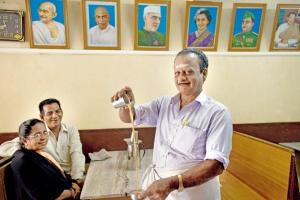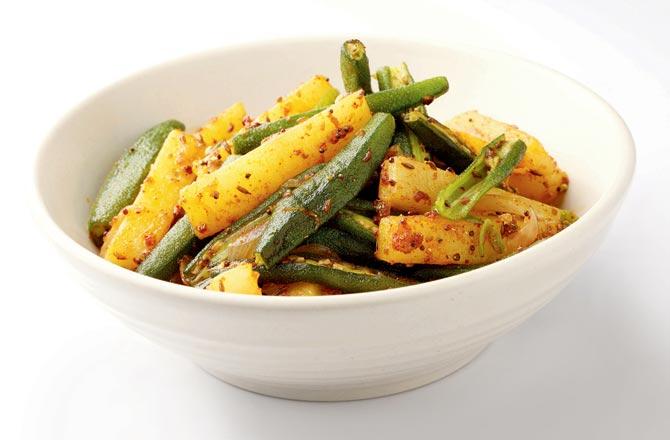shylashri Shankars new book explores the complex and hybrid food history of India, shaped by its geography and the Gods, seen through democratic stories of the middle class from various regions

A coffee house in Nagore. Shankar says coffee drinking in the south was more of a 20th century phenomenon. Rice water was the preferred drink, before this. Coffee became more acceptable after the rice shortages during World War I
To write a biographical account of food in a country as diverse and vast as India is daunting, admits Shylashri Shankar, a senior fellow at the Centre for Policy Research, New Delhi. And yet, Shankar has spent the last three years exploring India's relationship with food, and how it has shaped the Indian identity. "India is a multitude of little things, and a lot of different groups. No two groups are similar. That was very important for me [when researching]. One had to look at India as a hybrid, rather than an entity," she says.
ADVERTISEMENT
Her new book, Turmeric Nation: A Passage Through India's Tastes (Speaking Tiger), attempts to explore the pluralism of our foods, and how our geography, Gods, and even our attitudes influence what we consume. Turmeric, she shares, is symbolic of the commonality within this mosaic of a culture. "It has an ancient lineage; it was found in the cooking pots of the Harappans, who lived in North India in 2600 BCE. Turmeric is also ubiquitous in India; it is found [or aspired to, in the case of very poor Dalits] in the dal and sabzi prepared even for a simple meal. While its use is not universal, the craving for turmeric is pan-Indian," she writes in the book.

The author points out that while in South India, ladies finger is first boiled in diluted tamarind juice with salt and turmeric powder, before it is fried with onions, the Punjabi bhindi cooked in the north, has onions fried first. The availability of ingredients in these regions, determines the cooking technique
As a political science expert, Shankar is invested in questions of identity and caste. She explores why cooking techniques and spices used in South Indian preparations, are the opposite of North Indian styles. For instance, she references Meenakshi Ammal's 1950s South Indian cookbook, where ladies finger is first boiled in diluted tamarind juice with salt and turmeric powder, before it's sauteed in a pan with oil, fried mustard, pinched red chillies and black gram dal. Onions are added only in the end. In Punjabi bhindi, the onions are fried first and the bhindi is added along with coriander, chilli and fennel seed powders. Shankar concludes that it's often the availability of ingredients in the region, which determines our cooking technique.
Our ancestral past is also an important area of Shankar's study. Before working on the book, she says "her pre-conceptions were generally the pre-conceptions all of us have". "You think that what happened many thousands of years ago, has no bearing on the present," she says. But archaeological evidence from the Indus Valley Civilisation suggests that at least since 3,000 BCE, those "living in present-day Northern India and north of the Vindhya mountains were familiar with barley and wheat and rice, along with mustard and gram, and various millets, grapevines, and vegetables". Starches of lentils were recovered from the interior surface of storage jars, and that of eggplant, ginger and turmeric from a handi. "Even today, we prepare dal and khichdi, and we still cook in the particular way [as our ancestors did]. I realised that multiple centuries co-exist within our bodies and memories. We are influenced by our ancestors in ways that we don't know, which I found most surprising."

Shylashri Shankar
Other fascinating bits from her research include those about the evolution of cookbooks in India, and the invented traditions—drinking of tea and coffee, and the mass dining in Udupi hotels, which have now become the most Indian thing to do. "The early cookbooks, especially the imperial ones, didn't offer a glimpse of the common people. You only knew what was happening in the Imperial world—the feasts at Akbar's palace. During the colonial period, the story was more about the English, who came into this foreign land, and how they had to struggle to cope with the natives and their foods. In the present-day cookbook, the story is different. It's about everyday life, and people. It's about grandmothers revisiting memories of their family and childhood. The one in this [her book] is from the middle class, from different regions. Hence, the stories are more democratic."
Shankar also writes about how coffee drinking in the south, was more of a 20th century phenomenon. Rice water was the preferred drink, before this. Coffee became more acceptable after the rice shortage during World War I. "This brings me to the question, what exactly does it mean to be hybrid? It means incorporating something new, which then becomes an established way of life. In everything we've done, including our use of spices—we assume green chilli is Indian, but chilli was introduced to India from the Americas in the 16th century as a replacement for long pepper—how we respond to these new ways of being and [the passage of] time, play an important role in evolution of tradition," the author shares.
3000 bce
Time since northern India has been consuming wheat, barley, rice, and grapevines
Keep scrolling to read more news
Catch up on all the latest Mumbai news, crime news, current affairs, and a complete guide from food to things to do and events across Mumbai. Also download the new mid-day Android and iOS apps to get latest updates.
Mid-Day is now on Telegram. Click here to join our channel (@middayinfomedialtd) and stay updated with the latest news
 Subscribe today by clicking the link and stay updated with the latest news!" Click here!
Subscribe today by clicking the link and stay updated with the latest news!" Click here!







